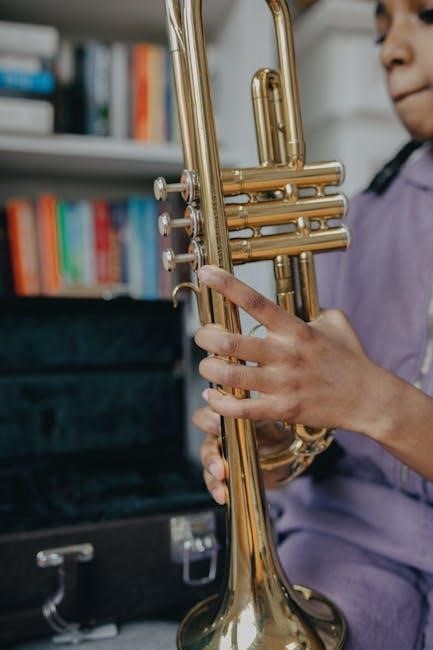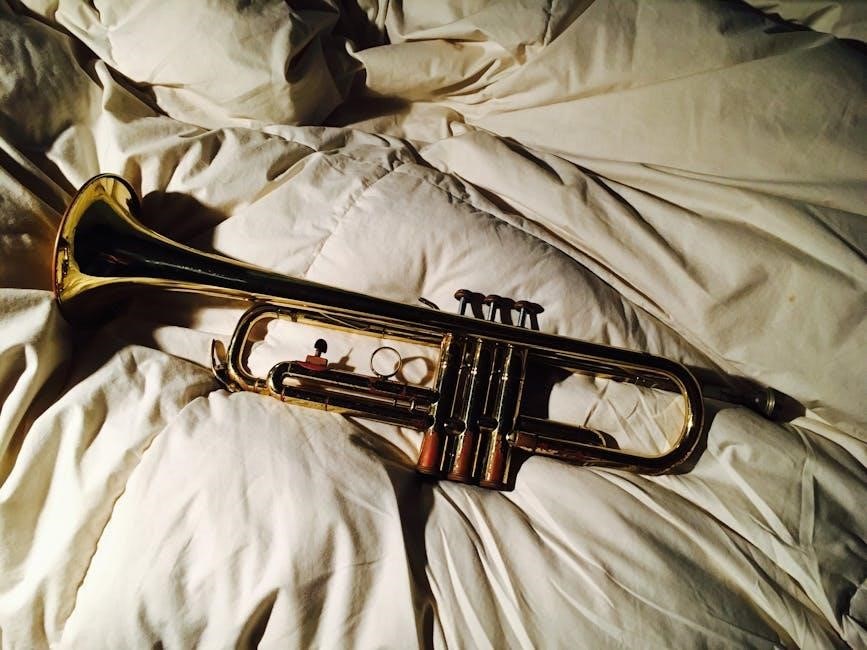
The Cherokee Trumpet PDF is a valuable resource for musicians‚ offering transcriptions of legendary solos by Clifford Brown and Charlie Parker‚ along with guides for mastering this iconic jazz standard․
Overview of the Cherokee Trumpet PDF
The Cherokee Trumpet PDF is a comprehensive resource designed for musicians seeking to master the iconic jazz standard․ It includes detailed transcriptions of solos by legendary artists like Clifford Brown and Charlie Parker‚ offering insights into their techniques․ The PDF features sheet music arrangements for various instruments‚ including trumpet‚ saxophone‚ and piano‚ making it versatile for ensembles or solo practice․ With clear notation and chord progressions‚ it serves as a valuable tool for both beginners and advanced players․ Additionally‚ the document provides historical context and performance tips‚ enhancing understanding and execution of the piece․ Its availability in both free and paid versions ensures accessibility for all musicians․
Importance of Cherokee in Jazz Music
Cherokee holds a significant place in jazz history‚ serving as a cornerstone for improvisation and technical mastery․ Composed by Ray Noble‚ it became a staple for bebop artists like Charlie Parker‚ who transformed it into a high-tempo challenge․ The song’s complex chord progressions and fast-paced structure make it a benchmark for musicians to showcase their skills․ Its enduring popularity lies in its versatility‚ allowing for creative interpretations while maintaining a foundational structure․ Cherokee is not just a tune; it’s a rite of passage‚ pushing artists to innovate and excel; Its influence spans generations‚ making it a timeless piece in jazz education and performance․
Why the Cherokee Trumpet PDF is Popular Among Musicians
The Cherokee Trumpet PDF is widely popular due to its accessibility and educational value․ It provides transcriptions of iconic solos by legends like Clifford Brown and Charlie Parker‚ offering insights into their techniques․ Musicians appreciate the clear sheet music‚ which is ideal for both beginners and advanced players․ The PDF’s availability in free and paid versions makes it accessible to a broad audience․ Additionally‚ it includes tips for mastering the song‚ practice strategies‚ and historical context‚ enhancing its appeal․ The PDF’s comprehensive nature‚ combined with its cultural and musical significance‚ makes it an indispensable resource for jazz enthusiasts and educators alike․

Historical Background of Cherokee
Cherokee‚ composed by Ray Noble‚ emerged in the 1930s and became a cornerstone of jazz‚ evolving through interpretations by Charlie Parker and Clifford Brown‚ shaping its legacy․
Origins of the Song Cherokee
Cherokee‚ written by Ray Noble in 1938‚ is a timeless jazz standard originally titled Cherokee (Indian Love Song)․ It gained prominence when introduced by the Charlie Barnet Orchestra‚ featuring a memorable solo by saxophonist Don Byas․ The song’s harmonic structure and fast tempo made it a favorite among jazz musicians․ Over time‚ it evolved into a bebop anthem‚ most notably through Charlie Parker’s iconic interpretation․ This transformation solidified Cherokee as a cornerstone of jazz repertoire‚ challenging instrumentalists with its complex chord changes and rapid-fire melodic lines‚ making it a benchmark for technical mastery and improvisational creativity in jazz music․
Evolution of Cherokee in Jazz Music
Cherokee‚ composed by Ray Noble in 1938‚ began as a vocal tune but quickly evolved into a jazz standard․ Its rise to prominence came with Charlie Barnet’s 1939 recording‚ featuring Don Byas’s saxophone solo‚ which became a defining moment in the song’s history․ Over time‚ Cherokee transitioned into a bebop anthem‚ with Charlie Parker’s virtuosic interpretation setting a new standard․ The song’s fast tempo and complex harmonic structure made it a proving ground for musicians to showcase technical prowess and improvisational creativity․ Clifford Brown’s iconic trumpet solo further cemented its legacy‚ while modern adaptations continue to highlight its versatility across instruments․ Today‚ Cherokee remains a cornerstone of jazz education and performance‚ with its sheet music widely available for study and interpretation․
Key Performances and Recordings of Cherokee
Cherokee has been immortalized through iconic performances and recordings‚ with Charlie Barnet’s 1939 version featuring Don Byas’s influential saxophone solo marking its emergence in jazz․ Charlie Parker’s bebop interpretation elevated the song’s status‚ while Clifford Brown’s legendary trumpet solo set a benchmark for technical brilliance․ Ray Noble’s original composition‚ along with arrangements by the UNT One O’Clock Lab Band‚ further popularized the tune․ These recordings not only showcased the song’s versatility but also served as foundational studies for musicians learning Cherokee․ The availability of transcriptions‚ such as Parker’s alto sax solo and Brown’s trumpet solo‚ has made these performances accessible for educational purposes‚ ensuring their lasting impact on jazz education and performance․

Structure and Composition of Cherokee
Cherokee is a 32-bar AABA-form composition‚ known for its fast tempo and complex harmonic structure․ Its challenging arpeggios and chromatic passages make it a staple in jazz education․
Musical Structure of Cherokee
Cherokee‚ composed by Ray Noble‚ is a 32-bar AABA-form jazz standard․ It is typically performed in the keys of Bb and Eb‚ making it accessible for both trumpets and saxophones․ The song features a fast tempo‚ often exceeding 240 beats per minute‚ and is renowned for its intricate harmonic structure․ The A sections are built on a series of descending chord progressions‚ while the B section provides a contrasting harmonic release․ The composition’s chromatic passages and complex arpeggios make it a challenging yet rewarding piece for improvisation․ Its harmonic richness and rhythmic complexity have solidified Cherokee as a cornerstone of jazz repertoire and education․
Chord Progressions and Harmony in Cherokee
Cherokee’s chord progressions are rooted in a 32-bar AABA structure‚ with the A sections featuring a descending sequence of ii-V-I patterns․ The harmonic framework includes extended chords like Dm7‚ G7‚ and Cmaj7‚ creating a rich‚ chromatic sound․ The B section introduces a contrasting harmonic release‚ often incorporating altered dominants and chromatic passing chords․ These progressions provide a complex yet cohesive foundation for improvisation․ The song’s harmonic structure‚ with its fast tempo and intricate changes‚ challenges musicians to navigate its dense chromaticism․ The use of harmonic substitutions and reharmonization techniques is common‚ making Cherokee a staple for advanced jazz study and performance․ Its adaptability allows for diverse interpretations while maintaining its core harmonic integrity․
Rhythmic and Melodic Elements in Cherokee
Cherokee is known for its fast-paced‚ intricate rhythmic structure‚ often performed at tempos exceeding 170 BPM․ The melody features syncopated eighth-note lines‚ creating a dynamic‚ driving feel․ Harmonically‚ the song relies on extended chord voicings and chromatic passing tones‚ adding complexity․ The rhythmic accuracy required makes it a challenging yet rewarding piece for musicians․ Melodically‚ Cherokee’s theme is memorable yet sophisticated‚ with a balance of stepwise motion and leaps; Solos often incorporate bebop phrasing‚ emphasizing rhythmic precision and melodic invention․ Clifford Brown’s and Charlie Parker’s solos exemplify this‚ blending intricate chromaticism with motivic development․ The interplay between rhythm and melody in Cherokee is central to its enduring appeal in jazz․

Key Trumpet Solos in Cherokee
Clifford Brown’s and Charlie Parker’s legendary solos on Cherokee are iconic‚ showcasing extraordinary bebop mastery and technical brilliance‚ inspiring generations of trumpet players with their timeless artistry․
Clifford Brown’s Cherokee Trumpet Solo
Clifford Brown’s Cherokee trumpet solo is a masterpiece of bebop‚ showcasing his technical brilliance and melodic ingenuity․ His solo‚ transcribed and widely available in PDF format‚ highlights intricate phrasing and harmonic depth․ Brown’s ability to navigate Cherokee’s complex chord changes with effortless precision has made his rendition a benchmark for trumpet players․ The solo exemplifies his warm‚ rich tone and lyrical approach‚ blending sophistication with emotional intensity․ Musicians studying this iconic performance can gain insights into advanced improvisation techniques and phrasing․ Brown’s Cherokee solo remains a cornerstone of jazz education‚ inspiring generations to explore the boundaries of bebop and beyond․
Charlie Parker’s Cherokee Solo Transcription
Charlie Parker’s Cherokee solo transcription is a seminal work in jazz‚ offering a detailed glimpse into his groundbreaking bebop style․ The PDF transcription‚ available for Bb instruments‚ captures his intricate phrasing and harmonic mastery․ Parker’s solo‚ originally recorded in 1940‚ remains a cornerstone of jazz education‚ showcasing his ability to navigate Cherokee’s complex chord changes with dazzling speed and precision․ Musicians studying this transcription gain insights into advanced improvisation techniques‚ melodic development‚ and rhythmic sophistication․ The document is widely used by educators and performers‚ making it an essential resource for anyone exploring bebop and Parker’s unparalleled artistry․
Ray Noble’s Cherokee Trumpet Solo

Ray Noble’s Cherokee trumpet solo is a timeless classic‚ featuring intricate arrangements and a sophisticated harmonic structure․ The PDF transcription‚ performed by the University of North Texas One O’Clock Lab Band‚ highlights Noble’s mastery of swing and phrasing․ This document is a valuable resource for trumpet players‚ offering insights into his melodic approach and technical precision․ The solo’s intricate rhythms and harmonic richness make it a staple for study and performance‚ providing a deeper understanding of jazz improvisation and ensemble playing․ Musicians can download and print this iconic piece‚ making it an indispensable tool for both educational and professional settings․

Musicians Who Popularized Cherokee
Cliff Brown‚ Charlie Parker‚ and Ray Noble are iconic musicians who popularized Cherokee through their extraordinary trumpet solos and innovative interpretations‚ making it a jazz legend․
Ray Noble and the Original Cherokee Composition
Ray Noble‚ a British composer and arranger‚ originally wrote Cherokee in 1937 as an instrumental piece for his orchestra․ The song quickly gained popularity and became a jazz standard‚ known for its catchy melody and complex harmonic structure․ Noble’s arrangement featured a 32-bar AABA form‚ which provided a robust framework for improvisation․ Over time‚ Cherokee evolved into a staple of bebop‚ with legendary musicians like Charlie Parker and Clifford Brown creating iconic solos․ The piece’s enduring appeal lies in its versatility‚ allowing artists to interpret it in various styles while maintaining its core identity․ Today‚ Noble’s original composition remains a cornerstone of jazz education and performance․
Charlie Parker’s Bebop Interpretation of Cherokee
Charlie Parker revolutionized Cherokee with his groundbreaking bebop interpretation‚ transforming it into a high-speed technical showcase․ His 1945 recording with pianist Bud Powell redefined the song‚ emphasizing rapid arpeggios and intricate melodic lines․ Parker’s solo‚ often considered a masterclass in improvisation‚ adhered strictly to the chord changes while introducing innovative phrasing and harmonic substitutions․ This version became a benchmark for jazz musicians‚ particularly in the development of bebop․ Parker’s interpretation not only elevated Cherokee but also set a new standard for jazz improvisation‚ inspiring generations of musicians to explore its complexities and push the boundaries of musical expression․
Clifford Brown’s Legendary Cherokee Solo
Clifford Brown’s iconic interpretation of Cherokee remains a cornerstone of jazz trumpet playing․ His solo‚ recorded with Max Roach in 1954‚ is celebrated for its technical mastery and lyrical elegance․ Brown navigates the fast tempo with precision‚ delivering intricate phrasing and harmonic depth․ His approach balances bebop complexity with melodic simplicity‚ making it a timeless study for musicians․ The solo’s transcription is widely available in PDF form‚ offering insights into Brown’s articulation‚ tone‚ and rhythmic accuracy․ It serves as a foundational resource for learning advanced improvisation techniques․ Clifford Brown’s Cherokee solo continues to inspire trumpet players‚ solidifying its place in jazz history as a masterpiece of musical artistry and technical brilliance․
Modern Artists Performing Cherokee
Modern artists continue to breathe new life into Cherokee‚ ensuring its relevance in contemporary jazz․ Musicians like Kamasi Washington and Chris Potter have delivered fresh interpretations‚ blending tradition with modern improvisation․ Ambrose Akinmusire’s soulful approach and Christian McBride’s dynamic arrangements further showcase the tune’s versatility․ These artists not only honor the legacy of Clifford Brown and Charlie Parker but also infuse Cherokee with their unique styles‚ appealing to both jazz purists and new audiences․ Their performances and arrangements are widely available as PDFs‚ offering musicians a wealth of inspiration and study material․ This enduring standard remains a testament to jazz’s evolution and its ability to captivate generations․

Cherokee Trumpet PDF Resources
Discover a wealth of Cherokee Trumpet PDF resources‚ including transcriptions‚ sheet music‚ and solo arrangements․ Explore free and paid options‚ ensuring high-quality materials for musicians․
Where to Find the Cherokee Trumpet PDF
Musicians can easily access the Cherokee Trumpet PDF through various online platforms․ Websites like Musicnotes‚ SheetMusicPlus‚ and JazzTranscriptions offer high-quality sheet music and solos․ Additionally‚ repositories such as Scribd and MuseScore provide free and paid versions of the transcription․ Many jazz education sites and forums also share user-contributed PDFs․ Universities and jazz bands often publish their arrangements‚ making it a rich resource for both beginners and professionals․ With a quick search‚ one can find the perfect PDF to suit their learning needs‚ ensuring they can master this iconic jazz piece effectively․
Free vs․ Paid Cherokee Trumpet PDF Options
Musicians can choose between free and paid Cherokee Trumpet PDF options․ Free versions are available on platforms like Scribd‚ MuseScore‚ and jazz forums‚ often shared by enthusiasts․ These may include basic sheet music or transcriptions but lack advanced features․ Paid options‚ found on Musicnotes‚ SheetMusicPlus‚ and similar sites‚ offer high-quality‚ professionally engraved PDFs with interactive features‚ multiple keys‚ and detailed annotations․ While free versions are great for previewing‚ paid PDFs are ideal for serious practice‚ providing clarity and precision․ Both options cater to different needs‚ ensuring accessibility for all levels of musicians․
Recommended Websites for Downloading Cherokee Trumpet PDF
Several websites offer reliable access to the Cherokee Trumpet PDF․ Musicnotes and SheetMusicPlus provide high-quality‚ professionally engraved sheets with interactive features․ MuseScore and Scribd host a variety of user-uploaded transcriptions‚ including solos by Clifford Brown and Charlie Parker․ For educational purposes‚ the University of North Texas Jazz Studies website shares official arrangements․ Additionally‚ jazz forums and communities often share free PDFs‚ though quality may vary․ These platforms cater to both beginners and advanced players‚ ensuring easy access to this iconic jazz standard․ Always verify the source for accuracy and clarity in the sheet music provided․

Learning to Play Cherokee on Trumpet
Mastering Cherokee on trumpet requires dedication to its complex melody and harmonic structure․ Start by learning the iconic Clifford Brown and Charlie Parker solos to gain inspiration and technical insights․ Practice with a metronome to improve timing and precision․ Break down challenging sections into smaller parts and gradually increase tempo․ Listening to recordings and playing along will enhance your phrasing and style․ Seek guidance from experienced educators or online resources to refine your approach․ Regular practice and a focused study plan are essential for mastering this jazz classic effectively․
Tips for Beginners Learning Cherokee
Beginners should start by learning the melody of Cherokee slowly‚ focusing on accurate pitch and rhythm․ Use the Cherokee Trumpet PDF to access clear sheet music and transcriptions of iconic solos․ Practice playing along with recordings of Clifford Brown and Charlie Parker to develop your phrasing and style․ Break down challenging sections into smaller parts and gradually increase tempo․ Incorporate a metronome to improve timing and precision․ Study chord changes and scales related to the tune to build harmonic awareness․ Seek guidance from experienced musicians or online tutorials to refine your technique․ Consistent practice and patience will help you master this iconic jazz standard effectively․
Advanced Techniques for Mastering Cherokee
For advanced players‚ mastering Cherokee involves refining phrasing‚ articulation‚ and harmonic complexity․ Study the Cherokee Trumpet PDF to analyze transcriptions of legendary solos by Clifford Brown and Charlie Parker․ Focus on intricate melodic patterns‚ chromaticism‚ and rhythmic precision․ Experiment with advanced improvisation techniques‚ such as altering chord tones and incorporating bebop scales․ Develop fluency in navigating the tune’s fast tempo by practicing with a metronome․ Explore harmonic substitutions and reharmonization to expand your musical vocabulary․ Incorporate ornaments like trills and upper neighbor notes for added expression․ Maintain clarity and precision in your sound‚ even at high velocities․ These techniques will elevate your performance of Cherokee to a professional level․
Practice Strategies for Cherokee Trumpet Solo
Mastering the Cherokee trumpet solo requires a structured practice approach․ Begin by breaking the piece into smaller sections‚ focusing on precise articulation and phrasing․ Use a metronome to build accuracy and confidence‚ starting at slower tempos and gradually increasing speed․ Practice scales and arpeggios in the key of Cherokee to improve technical facility․ Emphasize rhythmic precision by subdividing complex passages․ Record yourself to identify areas for improvement․ Analyze and transcribe solos by Clifford Brown and Charlie Parker to internalize their phrasing and style․ Incorporate dynamic contrasts and vibrato for expressive playing․ Finally‚ practice improvising over the chord changes to develop your own unique voice within the framework of this iconic jazz standard․

Cultural and Musical Significance of Cherokee
Cherokee embodies the essence of jazz heritage‚ serving as a benchmark for technical mastery and improvisational excellence‚ while its enduring popularity continues to inspire modern jazz innovation and appreciation․
Cultural Impact of Cherokee in Jazz History
Cherokee has left an indelible mark on jazz history‚ becoming a benchmark for technical mastery and improvisational excellence․ Its fast-paced chord changes and complex structure have made it a proving ground for musicians‚ particularly trumpeters․ The song’s popularity soared with iconic performances by Clifford Brown and Charlie Parker‚ whose solos are widely transcribed and studied․ It has also been a cornerstone in jazz education‚ helping musicians develop their skills․ The cultural significance of Cherokee lies in its ability to bridge generations‚ inspiring both traditional and modern interpretations․ Its enduring relevance ensures its continued influence on jazz‚ making it a timeless classic in the genre’s history․
Cherokee’s Role in Jazz Education
Cherokee is a cornerstone in jazz education‚ serving as a foundational piece for developing musicians․ Its complex chord progressions and fast tempo make it an ideal tool for teaching advanced improvisation and technical precision․ Many educational institutions use Cherokee to challenge students‚ fostering growth in both soloing and ensemble playing․ The availability of transcriptions‚ such as Clifford Brown’s and Charlie Parker’s solos‚ provides students with models for study and emulation․ Additionally‚ the song’s structure encourages exploration of harmonic concepts and rhythmic accuracy․ As a result‚ Cherokee has become a staple in jazz curricula‚ helping shape the next generation of musicians and ensuring its legacy endures․
Cherokee’s Influence on Modern Jazz Music
Cherokee’s enduring influence on modern jazz is evident in its widespread adaptation by contemporary artists․ Its intricate chord progressions and fast-paced structure continue to inspire musicians to push harmonic and rhythmic boundaries․ The availability of high-quality PDF transcriptions‚ such as Clifford Brown’s legendary solo‚ provides modern players with a blueprint for mastering complex improvisation․ Many modern artists incorporate Cherokee into their repertoire‚ blending traditional techniques with innovative interpretations․ This timeless standard remains a benchmark for technical proficiency and creative expression‚ ensuring its relevance in today’s jazz landscape․ Its impact is further amplified through educational resources‚ fostering a new generation of musicians steeped in its legacy․
The Cherokee Trumpet PDF remains an essential resource for jazz musicians‚ offering timeless solos and educational insights that continue to inspire and educate across generations․
Final Thoughts on the Cherokee Trumpet PDF

The Cherokee Trumpet PDF is a timeless resource for jazz enthusiasts‚ offering detailed transcriptions of iconic solos by Clifford Brown and Charlie Parker․ Its educational value lies in providing musicians with a deeper understanding of bebop and improvisation techniques․ The document serves as a bridge between historical performances and modern practice‚ making it accessible to both beginners and advanced players․ With its clear notation and versatility‚ the PDF has become a staple in jazz education and performance․ Musicians worldwide continue to rely on it for inspiration and technical refinement‚ ensuring Cherokee’s legacy endures in the world of jazz․
The Future of Cherokee in Jazz Music
Cherokee’s enduring appeal ensures its continued relevance in jazz․ The Cherokee Trumpet PDF‚ with its accessible transcriptions‚ will remain a vital educational tool‚ inspiring new generations of musicians․ As jazz evolves‚ artists will reinterpret Cherokee‚ blending traditional elements with modern styles․ The rise of digital platforms and sheet music resources will further democratize access to this iconic piece․ Educators and performers alike will leverage these materials to preserve and innovate‚ ensuring Cherokee’s legacy thrives․ Its influence will expand through diverse arrangements and performances‚ cementing its place as a cornerstone of jazz culture and education for years to come․